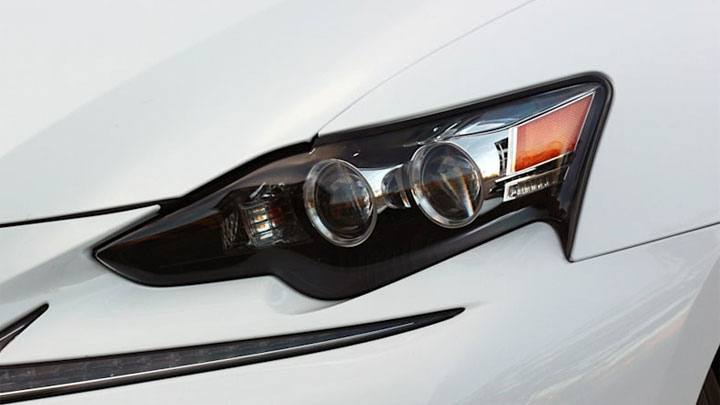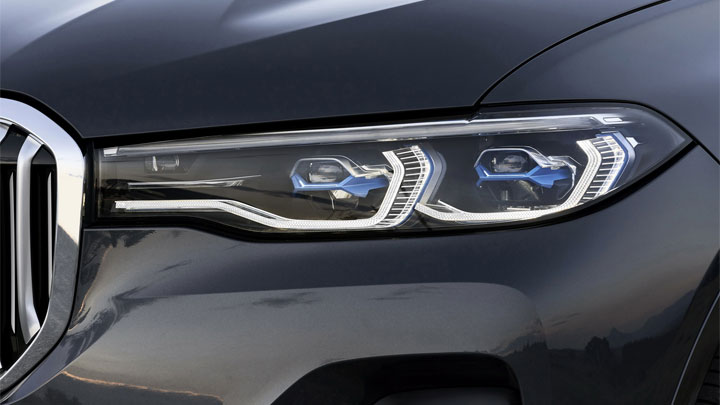HID vs LED vs Laser Headlights (Which Are Best?)
So you’ve come to the conclusion that the headlights on your vehicle are horrible and you want better lighting on your next vehicle. But with all the different types of headlights out there, which is best?
This article looks at the three most common headlight technologies (HID, LED, and laser) and how they differ based on brightness, lifespan, color, size, and cost. Use this info to make sure your next ride has incredible visibility at night.

See Also: 3 Reasons Your Brake Lights Won’t Turn Off
What are HID Headlights?
HID stands for High Intensity Discharge. When employed in an automotive headlight bulb, this technology lights the way in a manner that is unimaginable with the use of standard halogen bulbs.
HID headlights forgo the use of a traditional filament strand. Instead, bulbs of this configuration rely upon the use of xenon gas as their source of illumination.
Xenon, in high-pressure form, is excited through electrical input from an HID headlight’s high-voltage electrodes. Once excited, this supply of xenon is superheated into a plasma state, which presents a rich light-blue or white illumination.

Most HID headlights are used in conjunction with projector beam assemblies, which are intended to concentrate and direct the bulb’s beam. This maximizes the effectiveness of HID headlights, while also minimizing the chance of inadvertently blinding fellow motorists.
HID headlights have now been around for quite some time, first appearing in the 1991 BMW 7-Series. Over the 30-years since their rise to prominence, HID headlights have become known for their long service life, which averages more the 30,000 hours in most applications.
Overall, HID headlights serve as a viable alternative to the use of standard bulbs. In the majority of instances, properly installed HID headlights produce 2-3 times more output than halogen bulbs, while placing less draw on a vehicle’s charging system.
HID headlights can also be purchased for a relatively reasonable cost when compared to other types of aftermarket bulbs.
Related: How to Get Condensation Out of Headlights
What are LED Headlights?
LED stands for Light-Emitting Diode. While LED technology has been used in various technical roles over the past several decades, lighting of this type has recently gained substantial popularity within the automotive industry.
LED headlights do not use pressurized gas within their design, as is the case in both halogen and HID headlights. Instead, LED headlights discharge light through semiconductors, or diodes.
When energized, an LED bulb’s diode converts its electrical load into light energy. This light naturally takes on a bright white color. In general, the light projected from an LED bulb is brighter, and of much greater intensity, than that emitted by most standard halogen bulbs.

However, LED headlights also come in a number of individual colors. These varying colors are created through the use of colored lenses, which are applied over a bulb’s individual diodes. The legality of non-standard colored LED headlights generally differs by state.
Read Also: Turn Signals Blinking Too Fast? (A Bulb Upgrade Might Be the Reason)
One of the most significant advantages associated with LED headlight use applies to such a bulb’s relative efficiency. By design, LED headlights use a very limited amount of energy when in operation, especially when compared to that required by standard halogen headlights. This substantially reduces the load placed upon a vehicle’s charging system.
Overall, LED headlights prove quite valuable to the bulk of motorists who are in search of increased nighttime visibility. Lights of this configuration also look quite striking when in use, projecting a bright, crisp beam of light.
However, LED headlights also tend to be noticeably more expensive than both halogen and HID bulbs.
What are Laser Headlights?
The advent of laser headlights is a rather new development in automotive design, when compared to the emergence of HID and LED headlights. This technology was first introduced by BMW in 2011 when exhibiting their i8 Hybrid Concept.
While headlights of this design do indeed feature functional lasers, they do not project light in the same manner as most motorists would assume.
Contrary to popular belief, laser headlights do not project actual laser beams onto the road ahead. On the contrary, the lasers used within the lights of this configuration are actually reflected into a yellow phosphorus-filled lens. This phosphorus reacts to the input provided by the assembly’s lasers, by emitting an ultra-bright light.

The light produced by this reaction is then projected outward by a specialized reflector, through the headlight assembly’s outermost lens. As a result, no direct laser beams are ever cast in any direction where harm can be done.
Most laser headlight assemblies even include safety features that disable operation in the event of compromise during a wreck.
A number of manufacturers, including BMW and Audi, state that the lasers found within these headlights are 1,000 times brighter than average LED bulbs.
As a result, laser headlights project with far more authority than any other type of light currently available on the market. This can prove quite valuable when navigating winding, or otherwise hazardous roads under the cover of darkness.
At the current moment, laser headlight assemblies command a much higher price than typical HID and LED bulbs. While these prices are expected to be somewhat higher than the latter, due to the complexity of laser assemblies, it is quite reasonable to expect the cost of such units to fall slightly in the future.
Key Differences

Brightness
- HID – Quite bright, providing excellent visibility. In most cases, lights of this type project 2-3 times more output than standard halogen bulbs.
- LED – Very bright and slightly brighter than HID bulbs. Headlights of this type also cast illumination that is distinctively crisp in form.
- Laser – Far brighter than HID and LED alternatives. Headlights of this type commonly project to distances in excess of 1/4 mile.
Lifespan
- HID – Quite durable in most cases. Many manufacturers of HID headlights specify that their products carry an average lifespan of 2,000-3,000 hours.
- LED – Very durable with an advertised lifespan of up to 10,000-50,000 hours. Therefore, one can expect headlights of this configuration to last for a period of 5-10 years in ordinary circumstances.
- Laser – Extremely durable. The bulk of laser headlights are rated to exceed 50,000 hours of operation, though the true longevity of such headlights should become more apparent in the years to come.
Color Range
- HID – Can vary significantly in color, ranging from yellow to blue/purple. The difference between the coloring of one particular bulb to another lies in the exact temperature to which the Xenon gas within a bulb is heated.
- LED – Projects crisp, white-colored illumination. However, some specialty colored LED bulbs are available, which utilize custom lenses.
- Laser – Vast majority project light that is similar in color to that cast by the sun. However, it is quite reasonable to assume that different variations of laser-style lights will become available in the near future.
Size/Style
- HID – Very similar in size to that of standard halogen headlights. While not as compact as LED bulbs, one can expect bulbs of this type to provide proper fitment when carefully selected by application.
- LED – Slightly smaller than standard halogen bulbs. This is due to the fact that LED bulbs require no supply of high-pressure gas for use.
- Laser – In most cases, comes in the form of a unitized assembly, as no generic bulb is used. However, the lasers used within such lights are extremely compact in size.
Cost
- HID – Generally, more affordable than both LED and laser lights. Bulbs of this type command an average cost of $30-$100 per set.
- LED – Often cost more than their HID cousins, yet are far cheaper than laser models. Bulbs of this type average $50-$100 in retail cost.
- Laser – Quite expensive. Laser headlights typically cost more than $250 per set, and can even reach prices in excess of $500 depending upon the exact make and model of a vehicle.
See Also: 6 Reasons Your Tail Lights Don’t Work (But Brake Lights Do)
Which Headlight Technology is Best?
Choosing the perfect type of headlight for a particular application is largely subject to opinion. However, there are several situations in which one type of headlight carries a distinct advantage over its competitors.
If you find yourself in search of the brightest illumination for the money, it is quite difficult to argue against the value of HID bulbs. In fact, many new vehicles now come standard with HID headlights for this exact reason, including multiple models offered by Toyota, Lexus, Ford, and Audi.
On the other hand, many who own high-end performance vehicles or sports cars, find favor in LED headlights. This is often due to the crisp, striking appearance of the light emitted by LED bulbs, which often takes on a vivid white color.
For the driver that is interested in nothing but the latest tech, and has some extra cash burning a hole in their pocket, there is no more efficient lighting system available than those of the laser variety.
Laser headlights can project to distances in excess of 1/4 mile, thereby enhancing a motorist’s ability to identify and avoid hazards that lie ahead.
- P0480 Code (Symptoms, Causes, and How to Fix) - Apr 19, 2024
- Car Temperature Gauge Stopped Working? (Here’s Why) - Apr 15, 2024
- Ignition Coil vs Coil Pack (What’s the Difference?) - Apr 8, 2024
